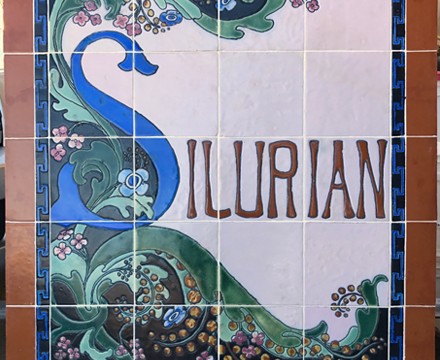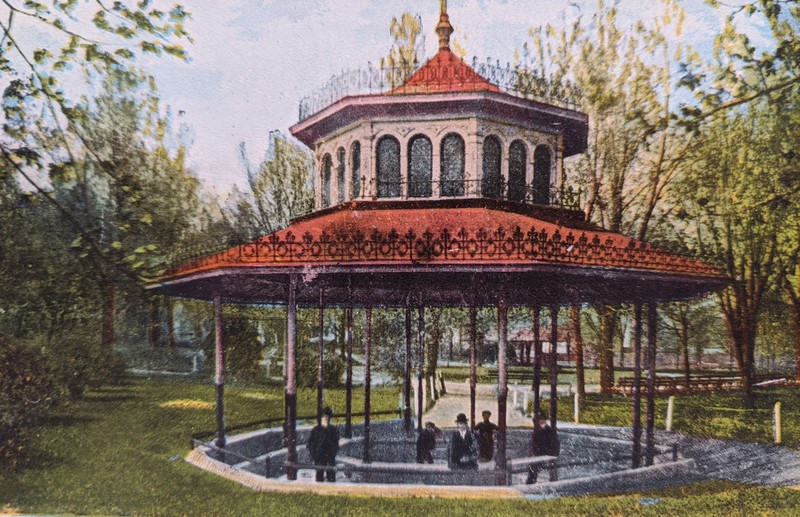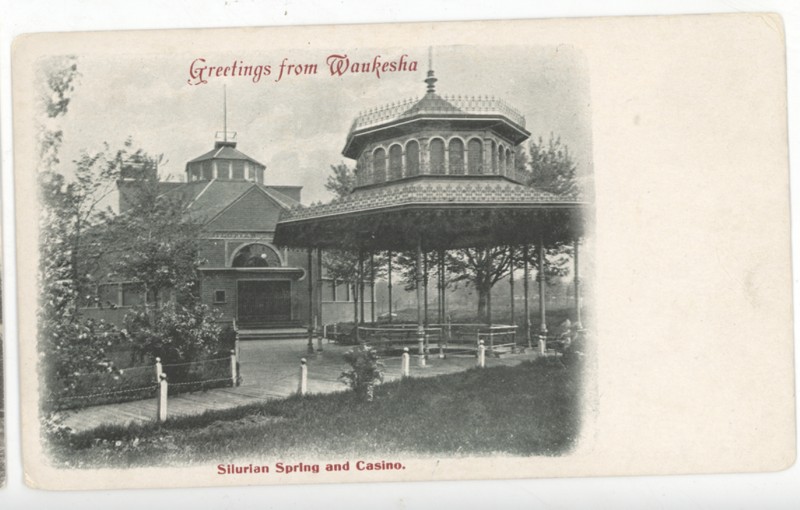Silurian Spring
Introduction
Text-to-speech Audio
Water from the Silurian spring was marketed as a "health water" for the first time in 1871, making it one of the oldest spring water sites in the city. The park around the spring was beautifully landscaped, with walking paths for visitors. Other amenities at the Silurian Spring park included a bath house, bottling plant, casino, and theatre. After falling into disrepair, the original 1880's springhouse was torn down and replaced in 1927 with a cement enclosed structure, still on the site today. A replica of the 1880's Silurian Springhouse was built and is located along the Fox River Trail, on Bank Street.
Images
Restored Tile from Marion Restoration

The Silurian Springhouse from postcard

Silurian spring
.jpg)
Silurian Spring and Casino postcard

Backstory and Context
Text-to-speech Audio
Named and owned by David Smeaton, a Waukesha businessman, the name Silurian come from the prehistoric sea that once covered the area. Smeaton owned the spring during the 1870's and steadily developed the spring site to attract the wellness tourists visiting the town each summer. Water from the Silurian spring was first marketed in 1871, however, the spring had been in use long before then.
The first advertisements for Silurian appeared in the Waukesha Freeman newspaper in 1874. Early advertisements stressed the medicinal and curative properties of the water, with a 1875 advertisement claimed that the water could cure diabetes, headaches, chills, indigestion, and many more ailments.
William A. Haslage of Pennsylvania came to Waukesha and Silurian Spring in 1879 in search of a cure for his diabetes. Impressed, and feeling his health improved, Haslage purchased the spring from Smeaton. Haslage then asked prominent Waukesha magnate James K. Anderson to be his partner in running the spring.
Work began immediately in improving the spring and the grounds around it. In late 1879, the spring was dug deeper to allow it to flow more freely. A new spring house was built over the spring to protect the water from contamination. This spring house was the most magnificent in Waukesha at the time it was built. The land around the spring was developed into a beautiful park and buildings on the grounds consisted of a bottling house, office buildings, and a popular bathhouse.
The partnership between Haslage and Anderson ended amicably in late 1880, with Haslage handling the business and Anderson working for him as the general agent. One innovation at Silurian during this time was the use of "block-tin pipe" to carry water underground to an indoor area to fill the barrels. Barrels were also lined with paraffin to insure that the water remained pure.
By the next year, Haslage's health has declined and he died on December 25, 1881. The spring was then sold to Luther McConnell, of Chicago, in August of 1882. James Anderson continued on as a manager for a few years before his brother William Anderson assumed operations. It was during this decade the spring gained major fame and success. Popular concerts were held in the park, there were fireworks, music, food, drinks, and of course Silurian spring water. In 1885 there was even a roller coaster constructed on the grounds of the park. Large amounts of Silurian water, along with Ginger Ale and carbonated water were bottled from the spring and shipped across the world.
In 1891, William Anderson resigned as manager and Lee S. Ovitt took over. By 1893, a huge casino and theatre were built right next to the spring with a stage that was 65 feet wide and the largest in the state. Elaborate plays and shows were put on in this theatre. Reports in 1895 told of Silurian having tennis courts. In 1896, a new machine was introduced in the bottling plant that killed all of the germs, sterilizing the bottles. Silurian sold aerated water, ginger ale, Silurian Vichy (water with vichy salts) and wild cherry phosphate.
McConnell sold Silurian to Clinton Warren, a hotel magnate, in 1897. Business slowly began to deteriorate and no new improvements were made to the park. Warren had a rocky tenure in Waukesha and by the turn of the century events at the park were ceased. Warren chose instead to focus more on the bottling business and in 1902 Silurian products were included as natural mineral water, ginger ale, wild cherry, and orange phosphate.
McConnell sold out in 1904. From that point on, Silurian slowly declined in stature. Frequent changes of ownership along with declining tourism to Waukesha’s springs in the later 1910s contributed to the park’s deterioration. In the 1920s, the original Silurian spring house was demolished, and a new fully enclosed polygonal concrete block structure was completed in 1927.
The business lasted into the 1930s, and products were bottled under the name “Silver King.” Tile murals on the outside of the spring house depict Silver King products.
The spring house has been restored several times and is usually open to the public a few times a year.
In 1984, a replica of the original Silurian spring house was constructed in downtown Waukesha. This replica has been moved along the Fox River Walk, near the present site of Waukesha State Bank.
Sources
Spring City's Past, Waukesha Landmarks Commission, January 2002.
Schoenknecht, John Martin. Great Waukesha Springs Era 1868-1918. Edition 1. Waukesha, WI. John M. Schoenknecht, 2003.
Waukesha County Democrat, August 7, 1880
Waukesha Resort Chat, 1899
Waukesha Freeman, 1874
“Waukesha, Wis., Bethesda Springs, Silurian Spring.” The Library of Congress, www.loc.gov/resource/det.4a04257/.
https://marionrestoration.com/portfolios/700-n-hartwell-ave-waukesha-wi/
Detroit Publishing Company photograph collection (Library of Congress)
